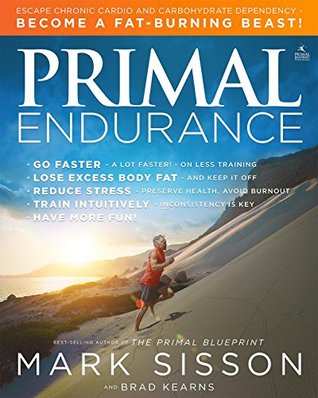More on this book
Kindle Notes & Highlights
by
Mark Sisson
Read between
March 23 - April 29, 2018
11. The cutoff point for aerobic training is the maximum aerobic heart rate, defined as the point where maximum aerobic benefits occur with a minimum amount of anaerobic stimulation. To calculate your maximum aerobic heart rate, use Dr. Phil Maffetone’s formula of: 180 − age = maximum aerobic heart rate.
PERIODIZATION 1. Periodization entails focusing on different types of training during specific blocks of time over a calendar year. The broad annual schedule is: aerobic base period, mini-periods of intensity/competition bookended by mini-periods of rest and aerobic, and finally a lengthy rest period to end the season.
Step 1 to going primal is to ditch sugars, grains, and industrial vegetable/seed oils for twenty-one days. Step 2 is to emphasize highly nutritious primal foods, such as meat, fish, fowl, eggs, vegetables, fruits, nuts, and seeds, and supplemental carbs like sweet potatoes—the natural plant and animal foods that fueled human evolution.
The Primal Essential Movements represent a safe, simple, effective, full-body workout sequence consisting of pushups, pullups, squats, and planks. A series of progression exercises allow athletes of all fitness levels to perform an appropriate number of reps and increase competency over time.
15. Sprinting in a pre-fatigued state is not only harmful for muscles, but also the central nervous system. Athletes should only sprint when 100 percent rested and energized to deliver a peak performance. Extensive warmup and technique drills should be performed before delivering maximum efforts.
16. A proper warmup entails dynamic movements that elevate your temperature, lubricate your joints (no cracking or creaking), and get your central nervous system focused on good technique with form drills. A deliberate cooldown will minimize the stress impact of the session and facilitate faster recovery. No abrupt endings!
Running is the best sprinting choice due to the benefits of weight-bearing intense activity. If you have joint or injury concerns, or specific competitive goals, you can sprint with low or no impact exercises. Ideal duration of sprints is between ten and thirty seconds, and four to six reps are plenty. Since running is harder, shorter and fewer work efforts are advised.
Walking will improve many aspects of your general health and also contribute to aerobic fitness by stimulating the complete range of aerobic muscle fibers and energy-producing enzymes.
Creating a standup desk environment is great, but the primary goal should be to create more variation in workplace positions—switching back and forth from standing to sitting, sitting on the ground, and going mobile whenever possible.
can. If you fall short of optimal sleep one day, take a nap the following day—instead of your workout!
an aerobic base period (minimum eight weeks). With success, high-intensity periods can follow, with a maximum duration of four weeks. Intensity periods are followed by micro periods of rest,
competition. The annual program always ends with an extended rest period or off-season,
Going primal entails first ditching the three most offensive foods in the modern diet: sugars, grains, and highly refined polyunsaturated vegetable
Becoming fat-adapted entails a twenty-one-day transition period where you train strictly at aerobic heart rates and eliminate refined carbohydrates.
0 to 50 grams per day: Ketosis and Accelerated Fat Burning Excellent catalyst for quick reduction of excess body fat.


